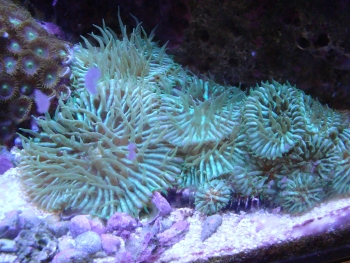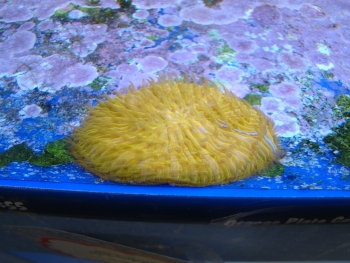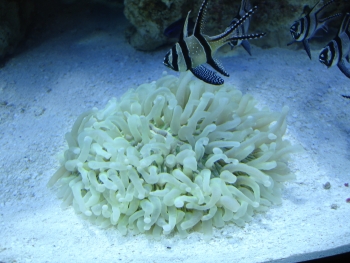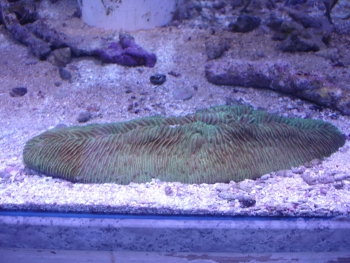
By Bob Goemans

When some aquarists think of ‘stony’ corals, they generally place them in the category of ‘reef-building’ corals, i.e., Hermatypic corals. However, where those in the Family Fungiidae are concerned, most are actually Ahermatypic corals, which are non reef-building free-living stony corals. Additionally, they are mostly solitary animals, i.e., they have one mouth, not numerous mouths, which should they, would technically place them in the colonial category.
There are 13 genera in this family, however, there are some unsettled points of view surrounding some genera/species. Alf Nilsen notes that a specimen called Fungia simplex (Veron, 1986; Hoeksema, 1989), is an exception when it comes to the solitary corals found in the Fungia genus, as it always has multiple mouths. Then there’s thought (Veron, 1986) that the genus Ctenactis is a subgenus of Fungia, which should include a questionable genus, Herpetoglossa, which then should include Fungia simplex.
Another interesting aspect is that most juveniles in this family are attached to rock or coral and become detached, i.e., free-living, as they grow larger. However, those in the genera Lithophyllon and Podabacia remain fixed, and are colonial species, and those in the genus Cantharellus, also remain fixed, but are a solitary species. Also, the related Family Fungiacyathidae contains some azooxanthellate/Hermatypic corals that come from non-reef areas and from very deep water, with one species, Fungiacyathus marenzelleri coming from a depth of over 23,000 feet (6,000 m)! But lets not anguish over these aspects/details, as most of the species in many of these genera are far from being common in the trade. Therefore, lets concentrate on what is important and should be known about the species we often keep in our aquaria.
They hail from the Western and Central Pacific Ocean, Indo-West Pacific regions, and the Red Sea, and some are among the largest of the solitary corals in the world. Most live in fairly shallow waters, e.g., less than 30 feet (10 m), where they are generally found on soft substrates on reef slopes, reef and lagoon flats, and interconnected sandy reef areas that are protected from very strong wave action.
The members of this family ‘generally’ form saucer-shaped specimens, although some do form elongated specimens, and have a slightly raised central area/dome, presenting convex topsides with a slightly concave bottom area. The domed top serves a good purpose, as it allows for sediments of various types to be easily shed when there is polyp extension and/or its cilia move the coverings downward toward their outer edges. These corals also have a heavy mucus coating that serves two purposes. It can easily reject deposited sediments by sloughing off the mucus, and because its mucus contains powerful nematocysts, can either capture food or sting offending corals. Nevertheless, its almost entirely unaffected by the stings from other corals including those within its own family. Tentacles are normally retracted during the day, and extended at night so as to feed upon the increased plankton content during these timeframes.
As for reproduction, there is both separate male and female specimens in some genera, and only hermaphrodite species in other genera. Sexual reproduction happens when eggs and sperm are released into the water. Asexual reproduction occurs when daughter (anthocauli) colonies form from pieces of skeleton and tissue from the parent. There are recorded happenings of asexual reproduction happening in aquariums, see attached photo by Bob Goemans of said happening in a local shop aquarium.
In aquaria, they should be placed on a sandy substrate in areas receiving bright light and moderate water movement. Even though photosynthetic, it should be fed at least once per week with meaty foodstuffs, e.g., fortified brine shrimp, mysis, products containing Cyclop-eeze, and/or other marine diced/graded meaty foods. Keep in mind that some species have short tentacle extension during the day, with further extension occurring in evening hours. Feeding should be at timeframes when tentacles are the most prominent.
Bare in mind these corals are phototaxic (move towards light) and can move (even up a slight grade), up to 12 inches (30 cm) per day. Should they touch another coral other than in their own family, it may generate mucus that could cause severe damage to the species its in contact with. And please, do not place these corals on ledges or rocks where they may fall from and be injured.
There four favorites that are almost always available in the trade;
Fungia scutaria (Lamarck, 1801), which is commonly called Plate Coral, Mushroom Coral, Disc Coral, or simply ‘Fungia.’ It hails from Eastern Africa to the Central Pacific Ocean, and the Red Sea. This is a solitary and usually saucer-shaped photosynthetic single polyp coral with a slightly raised central dome, and a single central mouth. Since it inhabits fairly shallow soft sand and coral rubble zones, it should be cared for as mentioned above. The most common color is green, however, other colors or combination of colors are occasionally available, sometimes with varying degrees of purple or red. I’ve never seen specimens larger than 5 inches (12.5 cm) in the trade; however, they can attain at least twice that size in the wild.
Cycloseris cf. hexagonalis (Milne Edwards & Haime, 1848) ‘or’ Cycloseris cf. tenuis (Dana, 1846). Their common names include Plate Coral, Mushroom Coral, Disc Coral, and Fungia. They hail from the Western and Central Pacific Ocean, Indo-West Pacific Regions and the Red Sea. This photosynthetic stony coral is similar in appearance to Fungia spp., which grows somewhat larger. This close relative is also a solitary, saucer-shaped photosynthetic stony coral, yet with only a ‘slightly’ raised central dome and a somewhat flat smooth back. Each disc represents a single polyp having a central mouth and in the wild, inhabits more sandy areas, i.e., soft sandy substrates on interconnected reef areas. These smaller family members, i.e. about 2 inches (5 cm) have colors that are usually white, tan, light green, or a yellowish-orange. They also should be placed on a sandy substrate in areas receiving bright light and moderate water movement and cared for as explained above. 
Note that the use of ‘cf’ – an abbreviation of the Latin word “conferre” meaning to compare, when used in the name of a species suggests the name is tentative, and is being used to compare it to an already known correctly described species. Therefore, two suggested species names are noted here. C. hexagonalis, is a species only occurring in the Western Pacific, whereas C. tenuis is more widely spread. Some authors have the shown species identified as possibly being C. hexagonalis, however, I doubt this because its color in the wild, i.e., tan or beige, does not match the color of C. tenuis in the wild, which is normally tan or yellowish-orange. More scientific effort is needed to resolve this issue, but until that time arrives, educated guesswork will suffice.
Heliofungia actiniformis (Quoy & Gaimard, 1833) hails from the Red Sea, Indo-Pacific Ocean, Philippines, and Micronesia to New Caledonia. Common names include Plate Coral, Disk Coral and Mushroom Coral. It’s another free-living solitary photosynthetic stony coral found in the same areas as the Fungia species. However, its long anemone-like tentacles are extended during the day and retract at night.  Therefore, feeding should take place during daylight hours when the tentacles are fully extended. Otherwise, their care remains the same. Comes in various colors, e.g., pink, blue, green, or brown.
Therefore, feeding should take place during daylight hours when the tentacles are fully extended. Otherwise, their care remains the same. Comes in various colors, e.g., pink, blue, green, or brown.
Herpolitha limax, Houttuyn, 1772, hails from the Red Sea, Indo-Pacific Ocean, and Eastern Africa, and are also found in similar areas, as are Fungia corals, however, are considered colonial corals as they often have a series of mouths running along the length of their central area. Similar in body height to Fungia coral, however, more elongated, hence their names Tongue or Slipper Coral. Sometimes found ‘Y’ or ‘V’ shaped, which is caused by regeneration of a damaged area.  Although, they are normally more ‘tongue’ shaped. This usually brown colored photosynthetic coral can get quite large, with specimens in the wild attaining three feet (1 m) in length. Does well in closed systems under low light and gentle water movement, and needs the same care as discussed above for Fungia corals.
Although, they are normally more ‘tongue’ shaped. This usually brown colored photosynthetic coral can get quite large, with specimens in the wild attaining three feet (1 m) in length. Does well in closed systems under low light and gentle water movement, and needs the same care as discussed above for Fungia corals.
In closing, even though all of the above are quite hardy and disease resistant, their long term survival in the captive system will not be possible unless there is sufficient open substrate areas for these animals to traverse, and of course, attention to its specific nutrition requirements. Furthermore, do not remove a specimen with inflated flesh from the water as the weight of the water in the flesh may damage/tear the flesh. Gently shake the specimen under the water first and allow the flesh to retract before removing.
As for their water quality requirements, the following should be adhered to: Calcium 380 – 430 mg/l, Alkalinity 3.5 meq/l, pH 8.1 – 8.2, Specific Gravity 1.025, and a temperature range of 74 to 83°F (23 – 28°C).
References/Good sources of information:
Borneman, E. H. 2001. Aquarium Corals - Selection, Husbandry, and Natural History. T.F.H. Publications, Neptune City, NJ.
Fossa, S. and A. Nilsen. 1998. The Modern Coral Reef Aquarium, Volume 2. Birgit Schmettkamp Velag, Bornheim, Germany.
Goemans, Bob (2005) Animal Library. http://www.saltcorner.com
Hargreaves, V.B. (2002) The Complete Book of the Marine Aquarium. Salamander Books Ltd., London.
Veron, J.E.N. 1986. Corals of World, Vol II. Australian Institute of Marine Science, Australia.
Wells, John W. 1966. Evolutionary development in the scleractinian family Fungiidae. The Cnidaria and Their Evolution. Symposia of the Zoologic Society of London 16: 223-46.
Yamashiro, Hideyuki, and Moritaka Nishihira. 1995. Phototaxis in Fungiidae corals (Scleractinia). Marine Biology 124: 461-5.
Phylum: Cnidaria
Class: Hexacorallia
Order: Scleractinia
Family: Fungiidae
Genus Cantharellus
C. doederleini
C. jebbi
C. noumeae
Genus Ctenactis
C. albitentaculata
C. crassa
C. echinata
Genus Cycloseris
C. colini
C. costulata
C. curvata
C. erosa
C. hexagonalis
C. patelliformis
C. renuis
C. sinensis
C. somervillei
Genus Diaseris
D. distorta
D. fragilis
Genus Fungia
F. concinna
F. corona
F. danai
F. fralinae
F. fungites
F. granulose
F. horrida
F. klunzingeri
F. moluccensis
F. paumotensis
F. puishani
F. repanda
F. scabra
F. scruposa
F. scutaria
F. seychellensis
F. spinifer
F. taiwanensis
Genus Halomitra
H. clavator
H. meierae
H. pileus
Genus Heliofungia
H. actiniformis
Genus Herpolitha
H. limax
H. weberi
Genus Lithophyllon
L. lobata
L. mokai
L. undulatum
Genus Podabacia
P. crustacea
P. lankaensis
P. motuporensis
P. sinai
Genus Polyphyllia
P. novaehiberniae
P. talpina
Genus Sandalolitha
S. africana
S. dentate
S. robusta
Genus Zoopilus
Z. echinatus